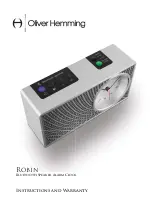
Fire Prevention and Safety
26
Care@Home™ Smoke Detector User Guide
Appendix A
Fire Prevention and Safety
Prevention and Planning
Installing smoke detectors is only one step in protecting a residence from fire. Similarly, the smoke
detector increases the probability that all residents can escape safely in the event of a fire.
To reduce the likelihood of fires, implement the following tips:
Install smoke alarms properly. Follow all the instructions in this manual. Keep the smoke
detectors clean and test them every month.
Replace a smoke alarm immediately if it is not working properly.
Follow fire safety rules and prevent hazardous situations, as follows:
Use smoking materials properly. Never smoke in bed.
Keep matches and cigarette lighters away from children.
Store flammable materials in proper containers. Never use them near an open flame or
sparks.
Keep electrical appliances in good condition. Do not overload electrical circuits.
Keep stoves, fireplaces, chimneys, and barbecue grills grease free. Make sure they are
properly installed and away from combustible materials.
Keep portable heaters and open flames such as candles away from combustible materials.
Do not allow rubbish to accumulate.
Keep a supply of extra batteries available for the battery-powered smoke detectors.
Explain to the children what the smoke alarm signal means.
Develop a family escape plan and practice it with the family.
Draw a floor plan of the residence and find at least two ways to exit each room. There
should be a way to exit each bedroom without opening the door.
Teach the children that they must be prepared to leave the home by themselves if
necessary.
Show the children how to check to see if doors are hot before opening them.
Show the children how to stay close to the floor and crawl if necessary.
Show the children how to use the alternate exit if the door is hot and should not be
opened.












































